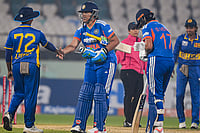A killer stalks the streets of Bombay, leaving behind a macabre trail. Corpses and clues are everywhere—from the busy grain godowns of Mandvi to the verdant village of Worli Koliwada, from the squalid alleys of Dongri to the hoity-toity slopes of Malabar Hill. The city is paralysed by fear, suspicion and impending doom.
Clearly, the perfect plot for a murder mystery. Only here, the killer is no garden-variety psycho with bloodstained knife and voices in the head. Instead, it is an invisible bacillus shaped like a miniature safety pin—a germ that strikes mysteriously across Bombay, bringing with it plague and rapid death.
Room 000 is about the Bombay Plague, the epidemic that first manifested itself in 1896 and continued to stalk the city for three heartbreaking decades. But this remarkable book—part history, part fiction—is about much more than a disease. It is about an infant science struggling to understand the world anew. It is the story of a group of scientists determined to defeat a tiny bacillus—men we have only otherwise met as statues and street signs. More than anything, it is the story of a familiar city in an unfamiliar time.
Ishrat Syed and Kalpana Swaminathan (who write together under the nom de plume Kalpish Ratna) have been chronicling Bombay for years, and have used pointillistic details to paint a vivid and compelling canvas. Their precise prose recreates the Bombay of the 1890s. This is a city in which many ‘natives’ live and die in crowded, rat-infested tenements. But it is also a city in which snotty Mems ‘eat the air’ in dainty carriages, supercilious Sahibs take part in hunts with peculiar names like The Bobbery, and Greek tycoons make pots of money.
Suddenly, alarming portents begin to appear in this divided, gaslit world. Reports of dead rats in the dock areas. Cases of inexplicable fevers that kill in days. Patients with horribly painful swellings in the groin and armpit. But it is on a Saturday in September 1896 that the tale really begins.
Accacio Gabriel Viegas, a doctor with a booming practice and a fondness for natty waistcoats, is frantically summoned to Vor Gaddi. A sick woman lies in a cramped, dim house. She has a high fever and unbearable pain caused by a marble-sized swelling. By the next day she is dead, “a bloody froth on her slack lips”.
Viegas is uneasy—especially when he encounters other patients with similar symptoms. But his colleagues dismiss his fears as ridiculous. “Plague-vague”, they shrug. “Poor people die, who cares why?”
So it is only three days later, when Nusserwanji Surveyor takes samples from patients and peers at them through his microscope, that the diagnosis is finally confirmed: The plague has come to Bombay.
After that, chaos and confusion reign. Haunted by dark memories of the great plague in London, the British administration panics. As nobody knows exactly how the disease spreads, everything is suspect. ‘Infected grain’ is destroyed. Food carts are overturned at random. Commuters are forced to lift their dhotis at the railway station and prove that they are free of bubos. People are evicted and their houses are flooded and pumped with nasty perchloride. The army marches into tenements to ensure that that no plague victim is being hidden away. Bizarre stories spread from area to area—“the wild imaginings of a terrified population”.
Still, corpse carts continue to roll out of hospitals. Armies of sick rats move north and west. While Bombay enacts “a grand opera of fear”, one room in the city is filled with the silence of absolute concentration. Room 000 in Grant Medical College.
This is where Dr Surveyor peers through his microscope and observes infected rats. Where E.H. Hankin, the chemical examiner of the government, puzzles over the information he has gathered about rats, the railways, the movement of sanyasis during the Kumbh Mela. Where W.M. Haffkine develops his plague prophylactic and struggles to understand ‘the identity’ of the plague bacillus.
It is here that these restless minds ponder over central questions: Where has the plague come from? How is it transmitted? What have rats to do with it? Why does it kill some people and not others? “They explored a science so new they had to make it up as it went,” write Syed and Swaminathan about the men of Room 000. “Its deductive logic fascinated them. It might take more than a lifetime but it would take them to the truth.”
And thanks to this wonderfully researched and imagined book, we are able to accompany the men of Room 000 on this quest.


























